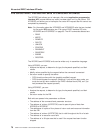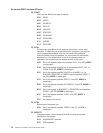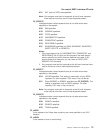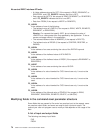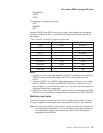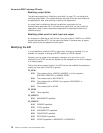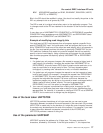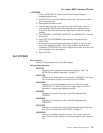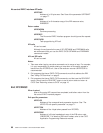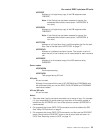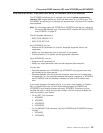X'01' NOSUSPEND specified (on READ, READNEXT, READPREV, WRITE,
DELETE, or REWRITE).
Bits in the EID should be modified in place. You should not modify the pointer to the
EID: any attempt to do so is ignored by CICS.
The EID is reset to its original value before return to the application program. That
is, changes made to the EID are retained for the duration of the file control request
only.
If more than one of UNCOMMITTED, CONSISTENT, or REPEATABLE is specified,
CONSISTENT takes precedence over UNCOMMITTED, and REPEATABLE takes
precedence over CONSISTENT and UNCOMMITTED.
Example of modifying read integrity bits
You might want all RLS read requests from all programs against a specific file to
specify CONSISTENT read. You could code a user exit program that turns on the
bit for CONSISTENT and turns off the other two read integrity bits in all requests to
the file. You could partially achieve this effect by specifying CONSISTENT on the
FILE definition. However, that would only override requests that did not explicitly
specify a level of read integrity. Using a global user exit program for this purpose
also overrides programs that explicitly specify UNCOMMITTED or REPEATABLE.
Warnings:
1. If a global user exit program changes a file request to request a higher level of
read integrity (for example, it changes the request from UNCOMMITTED to
REPEATABLE), this could cause CICS either to acquire extra read locks, or to
keep its read locks for a longer period of time. This may degrade system
throughput, by causing other transactions to wait, or introduce deadlocks.
2. If a global user exit program changes the request to one that requests a lower
level of read integrity (for example, it changes the request from REPEATABLE
to UNCOMMITTED), this could cause application logic errors to occur in the
program that originated the request. The errors could occur because the
application program may be relying on the record to remain unchanged while it
reads a series of other, related, records. This can be guaranteed with
REPEATABLE, but not if the option is changed to UNCOMMITTED.
3. Your user exit program is prevented from making major changes to the EID.
However, you must take great care when making the minor modifications that
are permitted. For instance, it is possible to change a DELETE into a GENERIC
DELETE, but to make such a change may be dangerous.
Use of the task token UEPTSTOK
UEPTSTOK provides the address of a 4-byte area that you can use to pass
information between successive file control requests in the same task. (By contrast,
UEPFCTOK is usable only for the duration of a single file control request, because
its contents may be destroyed at the end of the request.) For example, if you need
to pass information between successive invocations of the XFCREQ exit,
UEPTSTOK provides a means of doing this.
Use of the parameter UEPFSHIP
UEPFSHIP contains the address of a 16-byte area. This area consists of 4
characters, followed by 3 fullwords. If the first byte contains 'Y', this request has
file control EXEC interface API exits
Chapter 1. Global user exit programs 77




